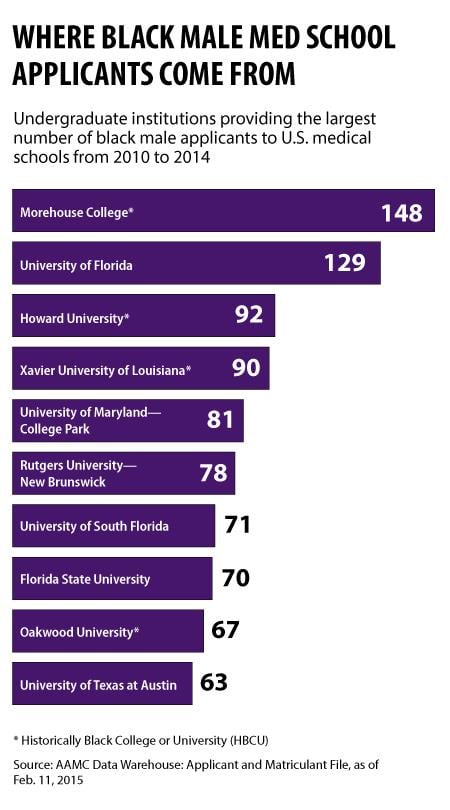Despite a recognized need for an increasingly diverse physician workforce, research confirms that fewer black men attend medical school today than in 1978. How can physicians and educators band together to help reverse this problem? A recent report from Academic Medicine outlines key diversity solutions.
Of all the common misconceptions about diversity in medicine, perhaps the most prevailing are that it only impacts students of color or fills perfunctory affirmation action quotas. But considering the outcomes for black patients—who have some of the highest rates of diabetes, heart disease and hypertension in the nation—such thinking couldn’t be farther from the truth.
In fact, a recent study in JAMA found that non-white physicians cared for 53.5 percent of minority patients and 70.4 percent of non-English-speaking patients, underscoring the crucial link between diversifying the physician workforce and reducing health disparities.
This is why “Altering the Course: Black Males in Medicine,” a new report from the Association of American Medical Colleges (AAMC), gathered the perspectives of 11 black premedical students, physicians, researchers and leaders through interviews to explore possible factors for the decline of black men in medical school and broad-based solutions to alter them.
While one solution won’t instantly curb the dearth of black men in medicine, institutions can take certain steps to connect with black men in their communities and attract more diverse applicants, according to the report. Some of these steps include:
Making diversity an actionable value and priority
For diversity initiatives to thrive, medical school leaders must believe in the importance of diversity and advocate for more institutional initiatives that support inclusion. School leaders should view diversity as an institutional asset that enriches the education and experience of all physicians in training—not only those of color. And they should implement inclusion programs that reflect this priority, according to the report. For instance, the University of California—Davis School of Medicine already is prioritizing diversity in its work within the AMA’s Accelerating Change in Medical Education Consortium, which received a $1 million grant to transform the way future physicians are trained. Administrators at UC Davis have adapted a diversity statement as part of the school’s official mission and offer a diversity education program, which provides staff, faculty and students with educational opportunities to learn more about inclusion through workshops and seminars.
Beyond rhetoric that openly supports diversity, interviewees in the report said it’s crucial for administrators to “examine existing policies and how they influence administrative practices” for students of color. For instance, a national study of admissions in university health programs in 2014 found that students admitted to medical school through a “holistic review process” performed just as well as those who were not. Schools that used a holistic review process “experienced increased diversity, no change to student success metrics and an improved teaching and learning environment,” according to the study. Physicians in the report encouraged admissions officers to consider a similar review process and shed the false perception that increasing diversity means lowering admission standards.
Developing mentorship programs
A lack of information about the medical school application process, financial concerns and scarce access to role models are common barriers to black men entering medicine, according to the report. To address these issues, the report suggested that medical schools should think creatively about pipeline and recruitment efforts, whether formal or informal, to engage black men and their communities. For instance, the AMA’s Doctors Back to School program allows physicians to visit K-12 schools in underserved communities and speak directly with students about their work as physicians. Students can learn more about how they can pursue a career in medicine. The report also recommends that schools investigate opportunities to connect with black men through premedical school programs, faith-based organizations, high school mentoring programs and the Student National Medical Association as well as the National Medical Association, the oldest and largest organization that specifically represents black health professionals.
Partnering with historically black college universities and minority organizations
HBCUs—such as Morehouse College and Howard University—are a major source of black male applicants to U.S. medical schools. In fact, four out of the top 10 institutions that provided the largest number of black male applicants to med schools were HBCUs in 2010-2014, according to recent matriculant data from the AAMC. In light of this, the report notes the importance of building stronger relationships with HBCUs as part of medical schools’ diversity strategies.
Hiring more physicians of color as medical school faculty and staff
Although medical school classes are increasingly diversifying, only 2 percent of medical school faculty at MD-granting institutions are black men, according to data from the AAMC. “The presence of other black men will likely influence decisions to attend a particular school or apply for a residency or faculty position,” according to the report.
- Learn about the 21 medical students the AMA Foundation recently selected as future minority physician leaders. Read their unique perspectives on being a student of color in medical school and how they plan to succeed while promoting diversity in medicine.
- See how these medical schools are tackling challenges in health disparities and cultural competencies.
- Educate yourself and your peers on the 5 myths of diversity in med ed.
- Watch this Google hangout to learn more ways schools and students are promoting diversity in medical education.
- Visit the AMA Minority Affairs Section Web page, which features the latest on AMA policies, news and events to promote diversity in medicine and public health. You can also join the section to get further involved.
Table of Contents
- Making diversity an actionable value and priority
- Enhancing school policies and administrative processes
- Developing mentorship programs
- Partnering with historically black college universities and minority organizations
- Hiring more physicians of color as medical school faculty and staff
- Want to explore more diversity solutions?




